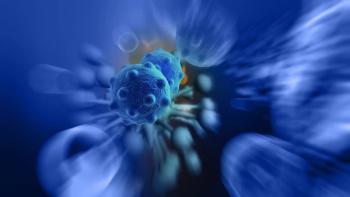
Ixazomib-Based Regimen Is Promising in Newly Diagnosed Multiple Myeloma
Investigators concluded ixazomib “may offer a more convenient, active, and well-tolerated alternative to a parenterally administered PI in this setting.”
Results of a phase I/II
“This study demonstrates the feasibility, tolerability, and antimyeloma activity of the all-oral IMP induction regimen followed by long-term maintenance with single-agent oral ixazomib in elderly, transplant-ineligible patients with newly-diagnosed multiple myeloma,” Jesus F. San-Miguel, MD, PhD, of Clinica Universidad de Navarra, Pamplona, Spain, and colleagues wrote in Haematologica.
“Oral dosing, coupled with a favorable safety profile at the recommended phase II dose, make ixazomib particularly suitable for long-term continuous therapy and may offer a more convenient, active, and well-tolerated alternative to a parenterally administered PI [proteasome inhibitor] in this setting.”
The phase I portion of the study enrolled 61 patients into four arms to investigate weekly or twice-weekly ixazomib combined with melphalan-prednisone. Patients in Arms A and B were treated with 13 or fewer 28-day cycles of the drug, and patients in Arms C and D received 9 or fewer 42-day cycles.
In phase I, about 1 in 4 patients reported dose-limiting toxicities during the first cycle, including grade 3 and/or grade 4 neutropenia in 6 patients, and thrombocytopenia in 4 patients. The recommended phase II dose was weekly ixazomib at 4.0 mg. In phase II, an expansion cohort was enrolled at the recommended dose.
At the final analysis, 4 patients remained on treatment. Reasons for discontinuation included disease progression, trial withdrawal, and completion of protocol-specific treatment.
With a median follow-up of 43.6 months for overall survival (OS), patients received a median of 16 cycles of ixazomib. Thirty-six patients went on to receive maintenance ixazomib, for a median of 12 cycles, the maximum duration of ixazomib treatment was 58 months.
About half of patients (48%) had a complete response (CR) or very good partial response (PR), 28% of these patients had a CR or better, and 48% of these occurred at the recommended phase II dose of weekly ixazomib 4.0 mg.
The overall response rate was 66%. The median times to very good PR and CR was 3.7 months and 11.6 months, respectively. One high-risk patient achieved CR and 3 high-risk patients achieved PR.
Maintenance therapy showed a deepening of responses in about one-third of patients, with 2 patients moving from CR to stringent CR, 5 patients moving from very good PR to stringent CR, and 3 patients moving from very good PR to CR.
“The number of patients who continued on long-term single-agent ixazomib maintenance therapy further emphasizes the tolerability of this regimen,” the researchers wrote.
The most common adverse events (AEs) of grade 3 or worse were thrombocytopenia, neutropenia, lymphopenia, leukopenia, anemia, and diarrhea. Hematologic toxicities occurred less frequently at the recommended phase II dose. There were three on-study deaths but none were considered to be treatment-related.
“Importantly, the continued clinical benefit demonstrated with weekly single-agent ixazomib maintenance therapy was complemented by a favorable tolerability profile,” the researchers wrote. “The majority of AEs were observed during the induction period, only 6% of patients discontinued ixazomib maintenance because of AEs, and no on-study deaths occurred during maintenance.”
Newsletter
Stay up to date on recent advances in the multidisciplinary approach to cancer.





